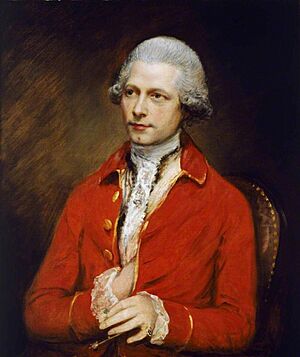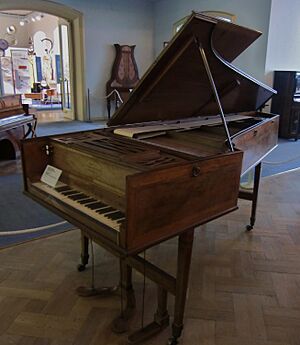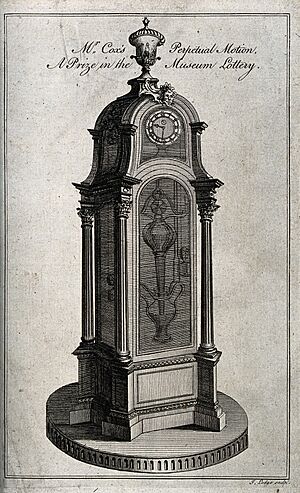John Joseph Merlin facts for kids
Quick facts for kids
John Joseph Merlin
|
|
|---|---|

Portrait of John Joseph Merlin by Thomas Gainsborough, 1781
|
|
| Born |
Jean-Joseph Merlin
6 September 1735 |
| Died | 8 May 1803 (aged 67) |
| Nationality | Belgian |
John Joseph Merlin (born Jean-Joseph Merlin, 6 September 1735 – 8 May 1803) was a super clever inventor, clock-maker, and musical instrument maker. He came from a place called the Prince-Bishopric of Liège, which is now part of Belgium.
Merlin moved to England in 1760. He became famous for creating amazing automatons (like fancy moving robots), such as the incredible Silver Swan. He also designed and built new kinds of keyboard instruments. In 1783, he opened his own museum in London, called Merlin's Mechanical Museum. It was a popular place for important people to visit.
Merlin is also known for inventing inline skates in the 1760s! People at the time called him "The Ingenious Mechanic" because he was so creative. He was even friends with the famous composer Joseph Haydn.
Contents
Merlin's Early Life
Jean-Joseph Merlin was born on September 6, 1735, in Huy, a town in what is now Belgium. His father, Maximilien Joseph Merlin, was a blacksmith. Merlin was the third of six children.
When he was 19, Merlin moved to Paris, France. He spent six years there, working with the Paris Academy of Sciences. This was a group of smart people who studied science.
Moving to England
Merlin arrived in England on May 24, 1760. He came as a technical helper for the new Spanish Ambassador in London.
In 1763, Merlin helped finish a large musical instrument called a barrel organ. It was built for the Princess of Wales. A year later, in 1764, the famous 8-year-old musician Wolfgang Amadeus Mozart even tried out this new organ!
Working with James Cox
By 1766, Merlin was working with a British jeweler named James Cox. Merlin was Cox's main mechanic. Together, they created amazing things. These included Cox's timepiece (a clock powered by air pressure) and the famous Silver Swan (1773).
Merlin also managed Cox's Jewelry Museum in London. This museum became a very popular place for fashionable people to meet between 1772 and 1775.
The writer Horace Walpole called the inventions shown by Cox and Merlin "scientific toys." Another writer, Fanny Burney, wrote about her characters visiting Cox's museum in her novel Evelina.
The famous writer Samuel Johnson visited the museum in 1772. He said that even if these inventions seemed like "trifles" (small things), the ideas behind them could be used for much bigger and more important purposes. He believed the same clever movements could be used to drain swamps, make metals, help builders, or even save sailors!
Musical Instruments
By 1773, Merlin was also busy designing and making his own keyboard instruments. He received a special patent (like a legal protection for his invention) in 1774. This patent was for a new part he added to a harpsichord to make it sound like a pianoforte.
Merlin had a workshop where his instruments were made. One of his special harpsichord-pianofortes might have even been owned by Empress Catherine the Great! Today, you can see some of his instruments in museums, like one from 1779 in Boston and one from 1780 in Munich. Merlin also experimented with violins and violas.
Merlin's Social Life
Merlin became friends with many important and wealthy people in London. A music expert named Charles Burney bought Merlin's instruments. He even played one in court to help Merlin protect his patent!
The composer Johann Christian Bach performed publicly on Merlin's instruments. Around 1774, the artist Thomas Gainsborough painted a picture of a musician named Johann Christian Fischer standing next to one of Merlin's pianos. Gainsborough also painted Merlin himself in 1781. In the painting, Merlin is holding a small beam balance he had invented.
The novelist Fanny Burney wrote about Merlin with kindness. She said he was a "great favourite" in her house. She found him funny and honest. Even though he was from another country, he spoke his mind freely and was grateful for kindness.
Merlin also seemed to enjoy being a bit unusual. He used parties and fancy dress balls to show off his inventions. He would appear in strange costumes. In 1778, a newspaper said Merlin was the most striking person at a big party. He came dressed as a "gouty gentleman" (someone with a foot problem) in a special chair he built. He could wheel himself around the room easily using two handles!
At another event, Merlin tried to play the violin while on roller skates he invented. It didn't go well! He crashed into a large mirror, broke it, broke his violin, and hurt himself badly.
Merlin's Mechanical Museum
By April 1783, Merlin was showing his musical instruments and automatons at his own museum. He invited people to visit his "Museum of Musical Instruments and Mechanical Inventions" in London.
Wealthy Londoners could meet their friends at Merlin's Mechanical Museum in the afternoon or evening. They would pay to see the exhibits and could also buy tea or coffee.
Merlin died in Paddington, London, on May 8, 1803. His collection of inventions was sold. One of his automatons, a dancer with an automated bird, was bought by Charles Babbage for 35 pounds. Babbage had seen it as a child at Merlin's Mechanical Museum.
Merlin's Inventions
Merlin was famous for making very clever automata. One of the most well-known was the Silver Swan, which he created with James Cox. Merlin also made many different kinds of mechanical clocks.
One of his most amazing clocks was Cox's timepiece. This clock was powered by changes in the air pressure around it! Another of Merlin's clocks was called the Merlin Band Clock.
Merlin also made many improvements to musical instruments.
- In 1775, he made a pianoforte with six octaves (a wide range of notes). This was 15 years before another famous company, Broadwood, made a similar grand piano.
- He improved the harpsichord.
- He created a special instrument that was a mix of a barrel-organ and a harpsichord, which could play 19 different tunes.
Merlin is also credited with inventing inline skates with two wheels in the 1760s. A book from 1805 tells the story of his accident while showing off his "skaites":
"One of his clever new ideas was a pair of skaites that ran on wheels. With these on and a violin in hand, he joined the crowd at a fancy dress party. But he hadn't figured out how to slow down or steer! He crashed into a mirror worth more than five hundred pounds, smashing it to pieces. He also broke his violin and hurt himself very badly."
Here are some other cool inventions Merlin created:
- A wheelchair that could move by itself.
- A special device to help someone born without full arms or legs.
- Whist cards for people who were blind.
- A pump to remove "foul air" (bad air).
- A system to call servants.
- A tea table that spun around when you pressed a pedal.
- A mechanical chariot (like a small carriage) with an early form of an odometer (a device that measures distance traveled).



